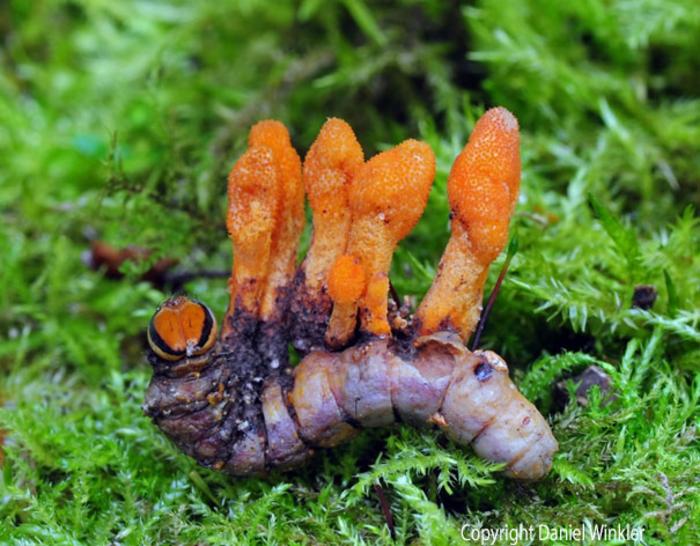Cancer-Fighting Potential Hidden in a Parasitic Caterpillar Fungus
Cordycepin disrupts cancer’s overactive cell signals without wreaking havoc on healthy tissue
Nov 7, 2024
[DALL-E]
Scientists have been studying a parasitic fungus, Cordyceps militaris, with an almost comical setup—it grows on caterpillars and has been used in traditional medicine for centuries, particularly in Asia. But beneath this quirky origin lies a serious, perhaps groundbreaking potential: a compound from this fungus, cordycepin, seems to hold powerful effects against cancer. Now, researchers at the University of Nottingham have cracked part of the mystery of how it works, hinting at a future where we could target cancer cells without the all-too-familiar collateral damage to healthy tissues.

Here's the background: the fungus produces a chemical called cordycepin. For decades, studies suggested it might fight cancer, but no one really understood the “how” behind its effectiveness. Cordycepin's cancer-busting reputation, then, was almost more of a folk tale than a scientific fact. Now, though, with the help of high-throughput technology, scientists can analyze the effect of cordycepin on thousands of genes at once, and it’s starting to look like the folk tale might be on to something.
The study, recently published in FEBS Letters, demonstrates how cordycepin interrupts signals for cell growth that go haywire in cancer. Think of it as traffic control at a busy intersection: in healthy cells, growth signals are kept in check, but in cancer cells, it's all green lights, all the time. Cordycepin appears to act like a red light, restoring some order to these chaotic signals. And unlike traditional cancer treatments, which often damage healthy cells in their scorched-earth approach, cordycepin may offer a far more targeted effect.
The Big Breakthrough: From Cordycepin to Cordycepin Triphosphate
A big leap in the research came from following cordycepin’s journey inside the cell. Once inside, the molecule undergoes a chemical transformation, turning into something called cordycepin triphosphate. If you’ve ever taken a biology class, you might recognize ATP, the molecule that powers cellular activity; cordycepin triphosphate looks suspiciously similar to ATP and may “trick” cancer cells by mimicking this energy source. The effect? The transformed cordycepin disrupts cancer cells’ abnormal growth patterns, stopping them from dividing and multiplying like a runaway train.
It’s a sneaky mechanism, one that might be key to its effectiveness. “We’ve been studying cordycepin across a range of diseases for years,” says Dr. Cornelia de Moor, who leads the team. “With every experiment, we get closer to understanding its potential. These days, it’s also easier and more affordable to run these large-scale analyses on thousands of genes, allowing us to uncover patterns and refine our hypotheses.”
Why This Matters
Cancer treatments today are a bit like using a sledgehammer to crack a nut. The tools we use—chemotherapy, radiation—are blunt and often harmful to healthy cells as well. Cordycepin, if we’re lucky, could be different. By targeting the growth signals specifically overactive in cancer, it may leave the healthy cells largely untouched.
So what’s next? Dr. de Moor’s data suggest that cordycepin is a strong candidate for drug development. If scientists can modify cordycepin derivatives to consistently reach its triphosphate form in the body, we might get a drug that’s even more potent against cancer. Additionally, they’ve identified particular genes that respond reliably to cordycepin, which could serve as indicators in future treatments, potentially allowing doctors to measure the drug’s effectiveness in real time.
Let’s Keep Our Expectations Real
Now, before anyone runs out to buy supplements or caterpillar fungus extracts, a word of caution. The journey from research lab to medicine cabinet is long and winding, full of twists where promising compounds turn out to be impractical or downright useless in actual patients. And while high-throughput data is exciting, it’s no substitute for rigorous, large-scale clinical trials that test real-world effects. So yes, this research is encouraging, but no one should start thinking of cordycepin as a miracle cure just yet.
But let’s not undersell the potential here, either. If nothing else, this study is a compelling reminder that valuable insights can come from the most unlikely places—even a fungus that grows on caterpillars. And if scientists keep asking questions and testing evidence, perhaps we’ll see cordycepin, or something like it, make its way from an ancient remedy to a cutting-edge cancer therapy.


















